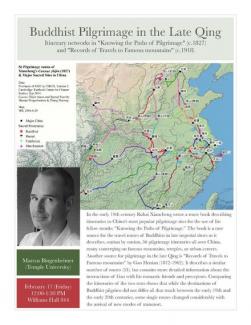Event

In the early 19th century Ruhai Xiancheng wrote a route book describing itineraries to China's most popular pilgrimage sites for the use of his fellow monks: "Kowing the Paths of Pilgrimage." The book is a rare source for the travel routes of Buddhists in the late imperial times as it describes, station by station, 56 itineraries all over China, many converging on famous mountains, temples, or urban centers. Another source for pilgrimage in the late Qing is "Records of Travels to Famous Mountains" by Gao henian (1872-1962). It descries a similar number of routes (53) but contains more detailed information about the itineraries of Gao with his monastic friends and preceptors. Comparing the itineraries of the two texts shows that while the destinations of Buddhist pilgrims did not differ all that much between the early 19th and early 20th centuries, some single routes changed considerably with the arrival of new modes of transport.

